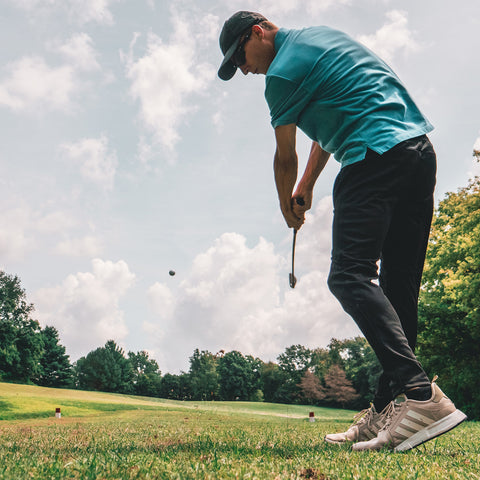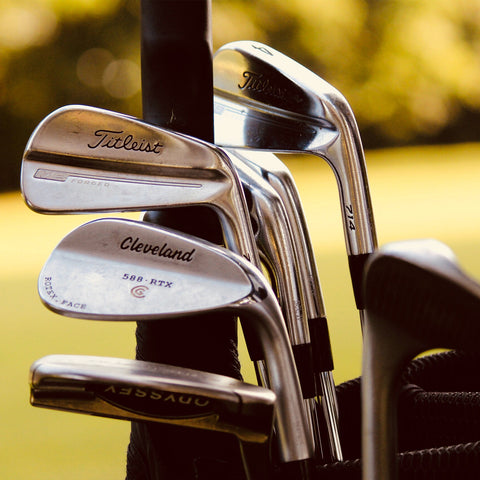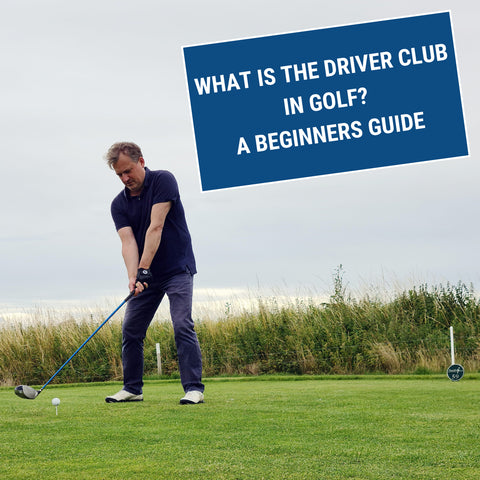Welcome to our in-depth look at irons, part of our series on understanding the entire range of different golf clubs. When you step onto the golf course, you carry with you a collection of clubs, each meticulously designed to serve a specific purpose. The question for many learners and even up to advanced players is which golf iron to use depending on the situation. Irons are a versatile selection of clubs that play an integral role in shaping your performance. Irrespective of whether you're a novice or an experienced golfer, the significance of irons in your bag cannot be overstated.
Table of Contents
- What Are The Parts of A Golf Iron Club?
- What Do The Numbers On The Golf Irons Mean?
- How Do I Know Which Golf Iron To Use?
- Modern Iron Club Technology In Golf
- Choosing the Right Irons: Navigating the Selection Process
- Swing Techniques: How can I Improve My Iron Shot?
- How To Clean Golf Irons
- The Appeal of Used and Second-Hand Irons
- Frequently Asked Questions (FAQ) About Golf Irons
What Are The Parts of A Golf Iron Club?
Every golf club is a masterpiece of engineering, and irons are no exception. To truly appreciate the artistry behind these clubs, let's dissect their anatomy, exploring the intricate components that come together to deliver those precise shots that define your game.
1. The Clubhead: At the heart of every iron is the clubhead, where technology and craftsmanship converge. The clubhead's design impacts forgiveness, ball trajectory, and shot control. From muscle back to cavity-back designs, the clubhead's shape and weight distribution affect how the club interacts with the ball upon impact.
2. The Hosel: The connection between the clubhead and shaft is the hosel. Its design influences the club's centre of gravity and how the clubhead interacts with the turf. Adjustable hosels allow players to fine-tune loft and lie angles, providing customization for individual playing preferences.
3. The Shaft: The shaft is the engine that translates your swing into the club's movement. Shafts vary in flexibility, length, and materials, each affecting the club's feel and performance. Graphite shafts offer lightweight options with enhanced vibration dampening, while steel shafts provide stability and control.
4. The Grip: Your connection to the club, the grip, can influence your swing and shot consistency. Grips come in various sizes, textures, and materials, catering to different hand sizes and playing conditions. Finding the right grip ensures a comfortable and confident hold on the club.
5. The Clubface: The clubface is where the magic happens—a small yet critical area that meets the ball. Grooves on the clubface enhance spin and control, especially when dealing with challenging lies. Different finishes and materials affect the clubface's interaction with the ball and the resulting ball flight.
What Do The Numbers On The Golf Irons Mean?
| Iron Number | Loft Angle (Degrees) | Typical Distance | Primary Uses |
|---|---|---|---|
| 2 Iron | 18-20 | Long Distance | Tee Shots on Par 4s and 5s, Approach Shots on Long Par 4s |
| 3 Iron | 21-24 | Long Distance | Tee Shots on Par 4s and 5s, Approach Shots on Long Par 4s |
| 4 Iron | 25-28 | Moderate Distance | Tee Shots on Par 4s and 5s, Approach Shots on Long Par 4s |
| 5 Iron | 28-32 | Moderate Distance | Approach Shots, Fairway Shots on Mid-Length Par 4s |
| 6 Iron | 32-36 | Moderate Distance | Approach Shots, Fairway Shots on Mid-Length Par 4s |
| 7 Iron | 36-40 | Moderate Distance | Approach Shots, Fairway Shots on Mid-Length Par 4s |
| 8 Iron | 40-44 | Short to Moderate Distance | Approach Shots, Fairway Shots on Short Par 4s |
| 9 Iron | 44-48 | Short Distance | Approach Shots, Controlled Shots around the Green |
| Pitching Wedge (PW) | 48-52 | Short Distance | Approach Shots, Bump-and-Run Shots, Controlled Shots around the Green |
As you delve deeper into the world of golf, you'll encounter a numbering system that carries significant implications for your gameplay. The numbering of irons—ranging from the lower end to the higher digits—holds the key to understanding the loft angle, distance, and versatility of each iron in your set.
1. The Significance of Numbers: The numbering system for irons corresponds to the loft angle of the clubface. The lower the number, the lower the loft and the greater potential for longer distances. Conversely, higher-numbered irons have higher loft angles, offering precision and control for shorter shots.
2. Varying Loft Angles and Distances: As you progress through your iron set, you'll notice distinct variations in loft angles and distances. Long irons, such as the 2, 3, and 4 irons, boast lower loft angles and are designed for shots that demand impressive distance off the tee or from the fairway. Mid irons (5-7) strike a balance between distance and accuracy, making them suitable for approach shots to the green. Short irons (8-PW) feature higher loft angles, allowing for controlled shots that land softly on the green.
How Do I Know Which Golf Iron To Use?
Golf is a game of precision, and the variety of irons at your disposal ensures you're equipped to handle diverse scenarios on the course. Your iron set is typically categorized into three main types: long irons, mid irons, and short irons.
1. Long Irons (2-4): The long irons, comprising the 2, 3, and 4 irons, showcase lower loft angles and are designed for maximum distance. These irons are your go-to choices for tee shots on longer holes or when you need to cover significant yardage from the fairway. While they demand precision in your swing, their ability to produce impressive distances is unrivalled.
2. Mid Irons (5-7): As you transition to the mid irons, including the 5, 6, and 7 irons, you encounter a balance between distance and control. These irons are your allies in approach shots to the green, where precision is essential. With slightly higher loft angles than the long irons, mid irons allow for controlled landings that set the stage for successful putts.
3. Short Irons (8-PW): The short irons, encompassing the 8 iron through the pitching wedge (PW), shine when accuracy takes precedence. With their high loft angles, these irons provide excellent control over distance. They excel in shots that require soft landings on the green, helping you avoid overshooting your target and setting up favourable opportunities for sinking putts.
Modern Iron Club Technology In Golf
Golf club design has undergone a remarkable transformation, and irons stand as a testament to the marriage of craftsmanship and cutting-edge technology. Delve into the realm of iron design, where innovation meets tradition, and explore how key advancements have shaped the way you approach the game.
1. Perimeter Weighting: The concept of perimeter weighting revolutionized iron design. By redistributing weight around the clubhead's edges, manufacturers enhance forgiveness on off-centre hits. This innovation minimizes the impact of mishits, allowing you to maintain consistency and accuracy even when your swing isn't perfect.
2. Cavity-Back Design: The introduction of cavity-back irons marked a significant departure from traditional blade-style irons. Cavity-back designs redistribute weight, focusing it towards the perimeter for enhanced stability and forgiveness. These irons are particularly beneficial for players seeking a balance between control and forgiveness in their shots.
3. Forged vs. Cast Irons: The debate between forged and cast irons reflects differing approaches to manufacturing. Forged irons are meticulously shaped by skilled craftsmen, resulting in a compact clubhead that offers enhanced feedback and control. Cast irons, on the other hand, leverage advanced casting techniques for consistent mass distribution and improved forgiveness.
The Impact of Innovation: These advancements in design and technology translate to tangible benefits on the course. The increased forgiveness from perimeter weighting and cavity-back designs reduces the penalty for mishits, allowing you to maintain better control over shot direction and distance. The choice between forged and cast irons hinges on your preference for feedback and control versus consistency and ease of use.
Choosing the Right Irons: Navigating the Selection Process
Selecting the right irons for your game is a journey that involves understanding your skills, swing dynamics, and playing style. Finding a harmonious match between your abilities and the irons you wield is essential for optimizing performance and elevating your game to new heights.
1. Tailoring to Skill Level and Swing Speed: Your skill level and swing speed play a pivotal role in iron selection. Novices might benefit from irons with enhanced forgiveness, while experienced players may lean towards clubs that offer greater shot-shaping control. Swing speed influences the choice between regular and stiff shafts, ensuring you achieve the right balance of distance and control.
2. Unveiling the Power of Custom Fitting: Club fitting is the compass that guides you towards the right iron set. Custom fitting takes into account your height, posture, grip, swing dynamics, and other factors to create a personalized set that complements your strengths and addresses your weaknesses. The result? Improved shot consistency, enhanced accuracy, and a seamless connection between you and your irons.
As the lines between tradition and innovation continue to blur, your iron selection remains a bridge to unlocking your full potential on the course. By embracing technological advancements and making informed choices based on your individual characteristics, you pave the way for a harmonious partnership between you and your irons—an alliance that translates into confidence, precision, and undeniable progress in your golf journey.
Swing Techniques: How can I Improve My Iron Shot?
As you stand over the ball with an iron in hand, you're embarking on a journey of precision and control. Perfecting your iron swing techniques is the key to unlocking consistent, accurate shots that shape your game. How do I stop my irons from shanking? Let's delve into the essential components of a successful iron swing, along with strategies to refine your skills and overcome common pitfalls.
1. Grip: Your grip serves as the foundation of your swing. A neutral grip, where the V's formed by your thumb and forefinger point towards your rear shoulder, fosters a square clubface at impact. Avoid a death grip—maintain a relaxed yet secure hold that enables fluid motion.
2. Posture: Your posture influences your swing's efficiency and balance. Bend at your hips, ensuring your spine forms a straight line. Knees slightly flexed, weight balanced between feet—this posture sets the stage for a dynamic, controlled swing.
3. Alignment: Proper alignment is the compass that guides your shots. Align your feet, hips, and shoulders parallel to the target line. Use intermediate targets to fine-tune your alignment, ensuring your clubface points where you intend.
4. Ball Position: The ball's position in your stance impacts trajectory and contact. For short irons, place the ball slightly ahead of centre; for longer irons, move it towards your lead foot. This ensures a descending blow and clean contact.
5. Common Mistakes and Improvements: Mishits often result from improper weight transfer, early release, or a hurried tempo. Work on maintaining a smooth tempo, shifting weight to your lead side, and delaying your wrist hinge through the backswing. Practice drills and video analysis can help identify and correct errors.
Approach Shots and Fairway Play: Precision with Every Swing
Approach shots to the green and fairway play are the stages where your iron skills shine. Mastering the art of iron shots in these scenarios requires a blend of technique, strategy, and adaptability.
1. Approach Shots: Approach shots demand a combination of distance control and accuracy. Choose the right iron based on the distance and consider factors like wind and hazards. Visualize your shot, align yourself, and execute with a confident swing that delivers the ball onto the green or near its vicinity.
2. Fairway Play: Navigating the fairway with irons requires a strategic mindset. Assess the lie and distance to determine the appropriate iron. Play the ball slightly back in your stance for crisp contact, and sweep the ball off the turf with a shallow divot. Focus on a controlled, rhythmic swing that minimizes side spin and maximizes accuracy.
3. Managing Lies: Uneven lies challenge your iron play. On an uphill lie, align your shoulders with the slope and play the ball towards your back foot. On a downhill lie, adjust your stance to match the slope, and position the ball slightly forward. These adjustments maintain contact and trajectory control.
From the precision of your grip to the strategy of your approach shots, every detail shapes your iron play. By refining your swing techniques and understanding how to tackle various course scenarios, you equip yourself with the tools needed to master the art of iron play—a skill that translates to better scores and a deeper appreciation for the intricacies of the game.

How To Clean Golf Irons
Your irons are more than mere tools; they're an extension of your skills and a gateway to success on the course. Proper maintenance and care are essential to ensure that your irons perform at their best, round after round. Let's dive into the world of iron care, from cleaning rituals to techniques that extend the lifespan of your beloved clubs.
1. Cleaning Rituals: After every round, make it a habit to clean your irons. A soft brush or towel can remove debris and dirt from the grooves. Dampen a cloth with warm water and mild soap to gently wipe down the clubheads. Be cautious when using wire brushes, as they can damage the clubface and grooves.
2. Groove Maintenance: Grooves on the clubface play a vital role in spin and control. Regularly clean out dirt and grass that accumulate in the grooves. A groove cleaner tool can help restore optimal performance. Avoid scraping the grooves with sharp objects, as this can negatively impact spin.
3. Rust Prevention: Irons are susceptible to rust, particularly if exposed to moisture. Dry your irons thoroughly after play, and store them in a cool, dry place. Applying a thin coat of clubhead oil can provide an additional layer of protection against rust.
4. Grip Check: Over time, grips wear down and lose their tackiness. Inspect your grips regularly for signs of wear and replace them as needed. A secure grip ensures proper control over the club, especially during wet conditions.
5. Shaft and Hosel Inspection: Check for any signs of damage or looseness in the shaft and hosel. If you notice issues, consult a professional club repair technician for assessment and potential repairs.
The Power of Regular Care: Regular maintenance and care not only enhance the aesthetics of your irons but also impact their performance. Clean grooves provide better spin and control, rust-free clubheads optimize ball contact, and well-maintained grips ensure a secure hold. By investing time in caring for your irons, you invest in consistent performance and a prolonged lifespan for your clubs.
The Appeal of Used and Second-Hand Irons
In the world of golf, new isn't always synonymous with better. While the allure of shiny, brand-new irons is undeniable, there's a certain charm and practicality in considering used and second-hand irons as well. These clubs carry a legacy, stories of swings and shots that have shaped their character over time. Let's explore the reasons why embracing the world of pre-owned irons can be a rewarding choice for golfers of all levels.
1. Cost-Effective Entry: For newcomers to the game, used irons offer an affordable entry point. Investing in a complete set of brand-new clubs can be a substantial financial commitment, especially for those testing the waters. Second-hand irons allow beginners to explore the game without breaking the bank, ensuring a cost-effective introduction to the sport.
2. Time-Tested Quality: Used irons often come from reputable brands and models that have stood the test of time. These clubs have proven their worth on fairways and greens, boasting design features that have withstood the evolving demands of the game. Acquiring such clubs means benefitting from the accumulated knowledge of generations of golfers.
3. Unique Character: Each used iron has a story to tell—a history of shots, successes, and challenges. Embracing second-hand irons allows you to connect with the heritage of the game and the players who wielded these clubs before you. There's a certain authenticity in swinging a club that's witnessed countless rounds and victories.
4. Personalized Selection: The used iron market offers a diverse range of options, catering to different preferences and playing styles. Whether you're seeking forged blades for precision or cavity-backs for forgiveness, you're likely to find a club that aligns with your game strategy. This personalized selection empowers you to curate a set that suits your needs.
5. Sustainability and Conservation: Opting for pre-owned irons contributes to sustainability efforts within the golfing community. By extending the lifespan of clubs, you help reduce the demand for new manufacturing, thereby conserving resources and minimizing waste. It's a small step towards preserving the environment while enjoying the sport you love.
6. Value Retention: Just as a new car depreciates the moment it's driven off the lot, brand-new clubs lose value quickly. Used irons, on the other hand, offer a more stable resale value. So, if you decide to upgrade in the future, you're likely to recover a significant portion of your investment when selling or trading in your used set.
Finding the Right Fit: When exploring the realm of used irons, it's important to conduct thorough research. Consider factors like the club's condition, age, and the reputation of the seller. Inspecting the clubface, grooves, shaft, and grip can provide valuable insights into its performance potential.
Frequently Asked Questions (FAQ) About Golf Irons
1. What is a good brand of golf irons?
Choosing a golf iron brand often depends on personal preferences and playing style. Some popular and reputable brands known for their quality irons include Titleist, Callaway, TaylorMade, Mizuno, and Ping.
2. How do I know what golf clubs I need?
Determining the golf clubs you need involves considering factors like your skill level, playing style, and course conditions. Typically, a golfer's bag includes a mix of woods, irons, wedges, and a putter. Consult with a professional or experienced golfer for personalized recommendations.
3. What irons are more forgiving?
Game improvement irons or cavity-back irons are known for their forgiveness. These irons have a larger sweet spot and perimeter weighting, making it easier to achieve better results even on off-centre hits.
4. What is an A in golf irons?
In golf irons, "A" stands for "Approach" or "Attack" wedge. It's also known as a gap wedge and typically has a loft angle between that of a pitching wedge and sand wedge.
5. What is T and F in golf?
In golf, "T" often refers to "Tournament" or "Teaching" tee markers, indicating the distance from which a round is played. "F" might indicate a forward tee position, allowing shorter hitters to play a more suitable yardage.
6. What is an L wedge in golf?
An "L" wedge, also known as a "Lob" wedge, is a high-lofted club used for shots that require a steep trajectory, such as hitting the ball over obstacles or onto the green from short distances.
7. What is the difference between an A and P wedge?
The "A" wedge, or gap wedge, has a loft angle between that of a pitching wedge (P) and a sand wedge (S). It's used for approach shots from distances that fall between the ranges of a pitching wedge and a sand wedge.
8. What does C wedge stand for?
The "C" wedge usually refers to a "Chipper" wedge, which is a specialized club designed for chip shots around the green. It has a unique shape and loft angle that helps golfers execute bump-and-run shots with accuracy.
9. What is an F wedge in golf?
An "F" wedge might refer to a "Fairway" wedge, which is a relatively new type of club designed for shots from the fairway. It combines the characteristics of both irons and hybrids to provide versatility and distance control.
10. How do I know what wedge to use?
Choosing the right wedge depends on the distance, lie, and shot type you're facing. Generally, a pitching wedge is used for longer approach shots, a gap wedge for mid-range shots, a sand wedge for bunker play, and a lob wedge for short, high shots.
11. What does P mean on a golf club?
In golf irons, "P" stands for "Pitching" wedge. It's one of the standard clubs in a set and is used for approach shots to the green.
12. What does W on a golf club mean?
"W" often stands for "Wedge" on a golf club. It indicates that the club is a type of wedge, designed for specific short-game shots around the green.
13. What does the P stand for in irons?
In irons, "P" usually stands for "Pitching" iron, indicating the club's loft angle and its primary use for approach shots to the green.
Feel free to refer to this FAQ section for answers to common questions about golf irons and related terminology. If you have more inquiries, don't hesitate to seek advice from golf professionals or experienced players.
 Free UK Delivery On Orders Over £25
Free UK Delivery On Orders Over £25
 90 Day Returns
90 Day Returns



